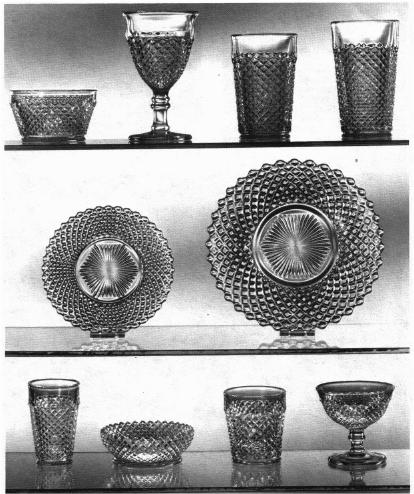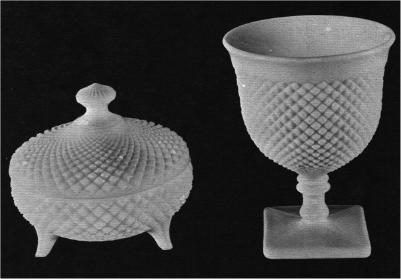National Depression Glass Association
Preserving America's Glass Manufacturing Heritage
Westmoreland Glass Company - English Hobnail
by Barbara Shaeffer
Glass Review - February 1985
Westmoreland Glass Company first began as the "Westmoreland Specialty Company" in 1890 at Grapeville, PA.
Just five years short of marking its one-hundredth anniversary, the Westmoreland factory is no longer making glass. In fact, all glassware in their inventory was sold at auction last month. Even items from their archives were liquidated.
 Many of their 3,500 moulds have been
sold. Most of their larger lines - English Hobnail, Princess Feather,
Colonial, Ashburton, Paneled Grape, etc. are being offered as a group
only and as of 12-20-84 had not been sold. You'll read elsewhere in
this issue which moulds were sold to Summit Art Glass Company,
Rootstown, OH.
Many of their 3,500 moulds have been
sold. Most of their larger lines - English Hobnail, Princess Feather,
Colonial, Ashburton, Paneled Grape, etc. are being offered as a group
only and as of 12-20-84 had not been sold. You'll read elsewhere in
this issue which moulds were sold to Summit Art Glass Company,
Rootstown, OH.
On my visit in mid-December, 1984 I was given about 200 black and white photos of various items they have produced over the years. I will be sharing these photos over the next months with our readers.
To start with I am showing pieces of their very popular "English Hobnail" pattern.
In the 1920's this pattern was referred to as No. 555, "a Sandwich Reproduction". Later It was advertised by the company as "English Hobnail".
Crystal "English Hobnail" has been in continuous production from the mid-1920's through the 1970's. Amber first appeared in 1925 and again recently. In the 1960's an amber called Golden Sunset was made. This is hard to distinguish from the earlier amber.
Rose, green and blue was made in 1926 to 1931. Several pieces of pink appeared in the 1980's.
A partial line was made with crystal bowls and black stems from 1929 to 1931.
Some topaz was made in 1930. In 1931 square "English Hobnail" was offered in Belgian Blue (deep blue) and Moonstone (opalescent blue).
In the late 1960's pieces were made with a flashed red trim.
In the 1970's footed salt dips were made in new colors such as peach, dark and light blue and some were frosted. This salt dip mold is now owned by Summit Art Glass Company.
Milk glass items have been made over the past 50 years.
An interesting fact is that "English Hobnail" will be found with various shaped bases - round, square or hexagon. Plates are either round or square. On original catalog sheets there is a distinction between round and square bases. The round line is No. 555 and the square is No. 555/2.
 |
 |
 |
 |
 |
 |